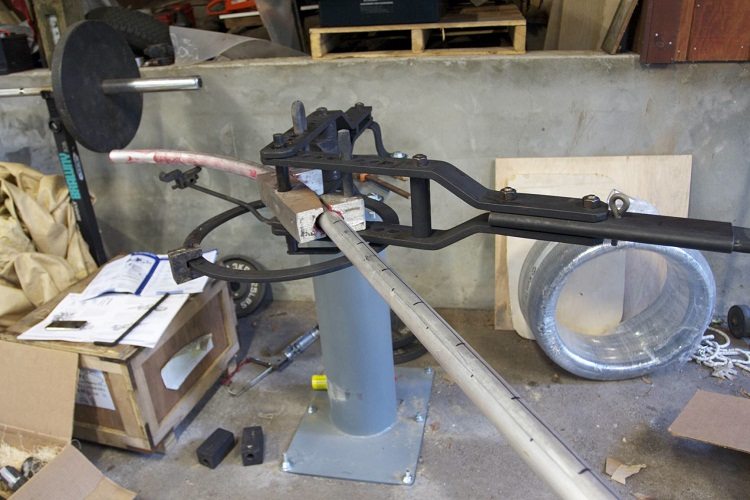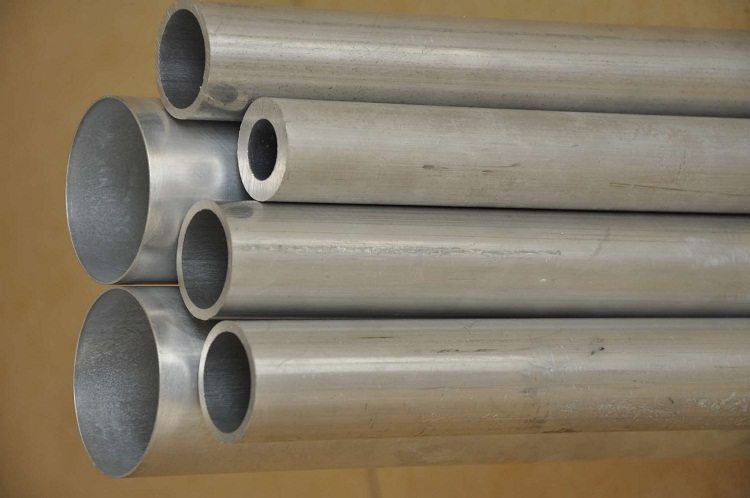Today, the production of aluminum products is extremely diverse and they are all in demand. This indicates the effectiveness and indispensability of this type of material in most applications. Let us dwell on the most popular type of aluminum product - the pipe.

It is possible to bend an aluminum pipe by various methods, with the help of technology and without it
Content
Characteristics of aluminum tubular products
Aluminum pipe - lightweight (one third of the weight of steel), ductile, non-corrosive, resistant to chemical and temperature effects (operating temperature from +150aboutC to -270aboutC), with high electrical and thermal conductivity, environmentally friendly and durable appearance of products. They differ:
- in the shape of a section into round, square, rectangular and shaped;
- by the method of production of cold-formed, pressed and welded;
- in length on measured, unmeasured, with multiple dimension, bay packing;
- chemical composition (grade Al) for high purity and technical purity.
Information about wrought alloys with marking and characterization of properties is presented in the table.
Table 1
| Hardening method | Deformable alloys | Mark | Impurities | |
| Pressure | Low strength | HELL 0 | 1050 A | Aluminum without impurity |
| HELL 1 | 1230 | |||
| High strength | AMC | 3003 | Al + Mn Manganese Impurities | |
| D 12 | 3004 | |||
| Medium strength and highly ductile | AMg 2 | 5251 | Al + Mg magnesium impurities | |
| AMg 3 | 5754 | |||
| AMg 5 | 5056 | |||
| AMg 6 | — | |||
| Temperature | Medium strength and highly ductile | HELL 31 | 6063 | Al + Mg + Si impurities of magnesium and silicon (air) |
| HELL 33 | 6061 | |||
| AD 35 | 6082 | |||
| Normally strong | D 1 | 2017 | Al + Cu + Mg impurities of magnesium and copper (duralumin) | |
| D 16 | 2024 | |||
| D 18 | 2117 | |||
| Normally strong | 1915 | 7005 | Al + Zn + Mg impurities of magnesium and zinc | |
| 1925 | — | |||
| High strength | At 95 | — | Al + Zn + Mg + Cu impurities of magnesium, copper and zinc | |
| Heat resistant | AK 4-1 | — | Al + Ni + Fe + Mg + Cu impurities of nickel, iron, magnesium, copper and zinc | |
| 1201 | 2219 | Al + Mn + Cu impurities of manganese and copper | ||
| For forging | AK 6 | — | Al + Mg + Cu + Si impurities of magnesium, copper and silicon | |
| AK 8 | 2014 | |||
Important! With an increase in the degree of impurities, the ductility of the alloy decreases, and the strength increases.
Aluminum products are ductile due to any mechanical stress. It is quite simple to bend an aluminum pipe even at home, while it remains intact. It is enough to observe some features of this operation.
What is the bending process and how to bend an aluminum pipe
When a straight aluminum pipe is bent at any angle, a deformation of the metal structure occurs, namely, the inner layer of the profile is compressed, and the outer is stretched. Since aluminum has a sufficiently low density, bending minimally injures the product. Alloyed aluminum gains high density during the production process, so such brands of pipe products do not bend so easily.
Flexibility allows you to mount structures of the most intricate shapes from aluminum pipes, while maintaining the cross section and integrity of the workpieces. The bending process itself takes place manually, using simple devices, or using specialized mechanisms, using preheating of the workpiece or in the cold state. It all depends on the size, type and structure of the product, wall thickness, the complexity of the bent shapes.
There are 4 main types of aluminum pipe bending (one plane): bend, bracket, duck, kalach. Workpiece with two folds of 135 degrees. - this is a duck, with three folds - this is a bracket (the angle in the center is 90 degrees, at the edges 135 degrees), with a bend in the semicircle - kalach, with a fold of 45-135 degrees. - this is a challenge. When bending, you must be guided by the following rules:
- if the aluminum pipe has a welded seam, then it must be bent so that the seam does not pass along a concave or convex bend line (perpendicular to the bent surface);
- if the diameter of the product is 15-20 mm, then the bend radius should be no less than the value of the outer diameter multiplied by 2;
- if the diameter of the workpiece is more than 25 mm, then the bend radius should be no less than the value of the outer diameter multiplied by 3.

Aluminum is a very soft metal, and non-compliance with the rules of bending will lead to rupture of the pipe
Advice! Whatever bending option is chosen, the main task is to avoid cracks, breaks, flattening, wrinkling of the concave part. This means choosing the right method and tool, observing safety rules when bending at home.
How the pipe bender will help
A pipe bender is the general name for special devices with a different operating principle, used for manual or machine bending of pipes, both profile and round, both at home and in professional workshops.
Using a manual pipe bender, aluminum plastic thin-walled products with a small diameter are bent. Among them:
- lever pipe bender (Volnov machine) - the workpiece is laid in a form where, under the influence of lever force, it bends without heating. The shape is made for a specific diameter;
- crossbow pipe bender - the workpiece is fixed in the structure, where the bending segment pushes the middle of the pipe in the direction opposite to the ends;
- spring pipe bender - a spring of the required diameter is laid in the pipe, and after heating the workpiece, it is either bent by a cold method, after which the spring is removed.
Machine bending is designed to bend workpieces of various diameters and shapes with minimal risk of damage. These are electromechanical and hydraulic mechanisms that provide an accurate bending result according to specified parameters. Such equipment provides the following bending methods:
- pushing method - bending by pushing an aluminum pipe (Ø up to 100 mm) between the rollers of the pipe bender, where one of the rollers performs the deflection function. The bend is arched with a minimum radius of curvature (the bend radius is equal to the diameter of the pipe times 6);
- rolling method - bending by rolling an aluminum pipe (Ø from 10 mm to 100 mm) through bending rollers, which are selected strictly according to the diameter of the bent product. Such an operation can be performed using a three-roll pipe bender, which performs bending with a ring, spiral, arc. It is used for both round and rectangular profile. Rolling is done several times;
- rolling method - bending by the impact of the rolling head of the pipe bender. The ball of the head bends the pipe under pressure, and where there is no pressure, the pipe bends in the opposite direction. Heating is not applicable. To avoid compression of the workpiece, the minimum bending radius should be 3 pipe radii;
- pressure bending method - bending by pressing with dies (deformation from the outside) or hydroforming (deformation from the inside by supplying water or oil to the pipe under pressure, the product bends within the mold).

The pipe bender of even the simplest design significantly reduces the risk of damage to the workpiece during bending
How to bend an aluminum pipe at home
First you need to determine the brand of pipe, diameter and wall thickness. If you decide to bend the aluminum structures of the house and more than once, then you can not do without a manual pipe bender. Buying such a device now is not difficult, the choice is very large. It is also possible to build an elementary pipe bending machine or stand.
There are also several ways to bend an aluminum pipe without a pipe bender at home. Such methods are suitable for small amounts of work.
Method 1 Fill the pipe with sifted, dry, fine sand, damp the ends with choppers, slowly bend the workpiece (even manually), securing one end to the clamp. Bend the workpiece and pour sand. Sand will allow preserving the roundness of the section, and in conditions of subzero temperature it can be replaced by water icing in the pipe. After bending, you need to place the finished part in heat so that the ice melts.
Method 2 If the pipe is not plastic (duralumin), then we use method 1 with sand and a gas burner. Fasten the pipe at one end in a vice, heat up the bend area evenly (250aboutWITH). Bring a piece of paper to the heated place, if it is smoking, the product is ready to be folded. Bend slowly. Do not allow multiple heating of the same section of the workpiece.
Method 3 Make a flat semicircular template from wood (thickness is greater than the diameter of the workpiece) with the desired bend radius, fix it on the plane with clamps or bolts. A board of the same thickness with a slope is fastened next to the template so that the pipe fits snugly between them. Lay the pipe with one end to the guide board in relation to the semicircle, bend its second end along the template. You can use this method for plastic pipes of any section up to Ø 40 mm. The method is applicable for bending a large radius.

Filling the pipe with ordinary sand allows you to bend it manually without the risk of damaging or breaking the workpiece
Method 4 Fill the pipe with sand according to method 1, put the ends of the workpiece on two support, stable planes, so that the bend is weighted. With a rubber mallet we form the desired bend in a place that does not fit on the supports. The method is well suited for products of square section.
Method 5 Place a steel spring of a smaller diameter in the bend section of the workpiece, to the end of which a wire is tied. Bend the pipe to the desired shape and pull out the spring by pulling on the wire. The bend can be warmed up if necessary.
Important! The length of the pipe after bending may vary, therefore, the required length of pipe should be formed after bending.
At home or in specialized workshops, bending an aluminum pipe with your own hands or using a pipe bender today will not cause difficulties. The main thing is to perform the bending process professionally, and for this you need to make the right choice of method and device, know the material and the measurable data of the pipe.






